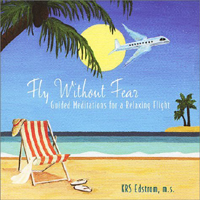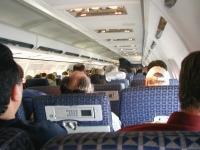|
|

|

Fear of Flying: How to Get Over Your Phobia of Flying in an Airplane
by SixWise.com
|
It's
no wonder, given the sensational news reports that follow
any flying tragedy, that 30 million Americans describe themselves
as "anxious" flyers. For some this involves a nervous
feeling for weeks before the flight. Others may go so far
as to cancel their flying all together -- business travelers
alone avoid 6 million flights a year because of flying anxiety.
Negative
media attention almost always serves to exacerbate these fears.
An extreme example was the 9/11 terrorist attacks. According
to one survey taken days after September 11, 27 percent of
people said they were avoiding flying for safety reasons,
compared with only 6 percent a year later in 2002.
|
 |

Business travelers avoid 6 million
flights a year due to fears
of flying.
|
|
Another
example is the recent spate of lasers aimed at cockpits, raising
fears that the light beams could temporarily blind crew members
and lead to accidents. However, news headlines, as tragic
and terrifying as they may seem, have nothing to do with your
actual risk of flying.
Flying
Tragedies are "Hot" News
If
you base your fear of flying on news reports, chances are
that you'll always feel anxious. Why? Flying tragedies always
elicit major ratings, which is why news outlets love reporting
on them. Arnold Barnett, a statistical expert in the field
of aviation safety, researched the New York Times front page
stories for one year and found some revealing data:
|
|

Finally, You Can Have a
Relaxing Flight!
Fly
Without Fear: Guided Meditations
for a Relaxing Flight provides guided
meditations and soothing music to
dissolve your fear of flying. Stress
expert KRS Edstrom guides you through
boarding, take-off, in-flight and landing
along with a desensitizing pre-flight
"dress rehearsal" exercise. This is
one CD you don't want to leave
home without!
|
 |
"1.7
murder stories for every 1,000 homicides, 2.3 AIDS stories for
every 1,000 AIDS deaths, .02 cancer stories for every 1,000
cancer deaths and 138.2 plane crash stories for every 1,000
airplane deaths."
What's
the Actual Risk?
According
to Barnett, the actual risk of a person being involved in
a fatal airline accident is once every 19,000 years. But that
is only provided the person flew on an airplane once a day
for 19,000 years!
And
according to one study reported in USA Today, it's 261 times
safer to fly from New York to Los Angeles than to drive.
Rationally
speaking, though, people can understand these statistics and
realize their risk is low, yet still feel anxious when boarding
a plane -- because most fear of flying is based on a purely
emotional -- not rational -- fear.
So
we could cite statistics about the safety of air travel all
day, and people would still have fears. This is why meditation
techniques like those in Fly
Without Fear, which address these emotionally based fears,
work so well.
|
What
are some of the specific reported fears that people have?
- Claustrophobia
- Heights
- Death
- Crowds
- Separation
from loved ones
- Fear
of falling
- Giving
control to the pilot
- Having
a panic attack
- Loss
of self-control
Tips
to Overcome Your Fear of Flying
- Get
your facts straight -- really think about how safe flying
actually is (it's much safer than driving).
- Use
meditation and relaxation techniques. SixWise.com highly
recommends Fly Without Fear: Guided
Meditations for a Relaxing Flight, an excellent
audio CD combined with soothing music in which stress
expert and former fearful flyer Krs Edstrom guides you
through the entire airport experience, from boarding
to landing.
- Breathe
deeply and intentionally.
- Get
counseling or join a self-help group. There are many
clinics, online programs, tapes and psychologists that
can help.
- Don't
indulge in alcohol as a way to cover-up your fears.
More
Practical Recommendations
|
- Fly
on non-stop routes. Most accidents occur during takeoff
and landings, so a non-stop route reduces the number of
takeoffs and landings during your trip.
- Choose
larger, newer aircraft. Planes that carry more than
30 passengers were designed under the strictest regulations.
A larger plane also provides more protection in the event
of an accident.
- Choose
airlines in developed countries, if possible. Airlines
in developed countries like the United States, Canada, and
Western Europe tend to have higher safety records than those
in developing countries.
|
 |

Always
listen to in-flight safety
announcements and flight
attendant instructions. Locate
emergency exits as you board.
|
- Listen
to safety instructions and flight attendants. Pre-flight
briefings by flight attendants let you know what to
do in the event of an emergency.
- Locate
safety exits. Knowing where to go to exit the plane
quickly during an emergency will help to ease your nerves.
- Don't
keep heavy objects in overhead bins. The objects
could shift during turbulence and injure passengers.
- Keep
your seatbelt fastened when in your seat. Sudden
turbulence can occur during flights. Having your seatbelt
fastened gives you added protection.
- Leave
hazardous materials at home. This one is rather
obvious, but be sure to leave gasoline, poisonous gases,
corrosives and other harmful materials at home.
And
before you leave for your next airplane trip, remember
that your risk of injury or death is 10 to 40 times greater
in an automobile than in an airplane traveling a comparable
distance.
Roger
Blackman, a psychologist at Simon Fraser University in
Burnaby, British Columbia, summed it up well by stating,
" ... for most people, the most dangerous part of
air travel is their trip by car to the airport."
|
To get more information about this and other highly important topics, sign up for your free subscription to our weekly SixWise.com "Be Safe, Live Long & Prosper" e-newsletter.
With every issue of the free SixWise.com newsletter, you’ll get access to the insights, products, services, and more that can truly improve your well-being, peace of mind, and therefore your life!
|
|
|
|